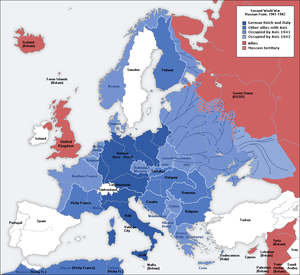Defense of the Reich
| Defence of the Reich | |||||||
|---|---|---|---|---|---|---|---|
| Part of Campaigns of World War II | |||||||
 Scope of the Defence of the Reich campaign. |
|||||||
|
|||||||
| Belligerents | |||||||
|
Other Allies |
|
||||||
| Commanders and leaders | |||||||
|
|
|
||||||
| Casualties and losses | |||||||
|
40,000 aircraft destroyed
79,265 American airmen |
57,405 aircraft destroyed
at least 23,000 motor vehicles destroyed At least 700-800 tanks 500,000 civilians killed at least 450 locomotives (1943 only) at least 4,500 passenger wagons (1943 only) at least 6,500 goods wagons (1943 only) |
||||||
40,000 aircraft destroyed
57,405 aircraft destroyed
The Defence of the Reich (German: Reichsverteidigung) is the name given to the strategic defensive aerial campaign fought by the Luftwaffe over German-occupied Europe and Nazi Germany during World War II. Its aim was to prevent the destruction of German civilians, military and civil industries by the Western Allies. The day and night air battles over Germany during the war involved thousands of aircraft, units and aerial engagements to counter the Allied strategic bombing campaign. The campaign was one of the longest in the history of aerial warfare and with the Battle of the Atlantic and the Allied Blockade of Germany was the longest of the war. The Luftwaffe fighter force defended the airspace of German-occupied territory against attack, first by RAF Bomber Command and then against the United States Army Air Forces (USAAF).
In the early years, the Luftwaffe was able to inflict a string of defeats on Allied strategic air forces. In 1939, Bomber Command was forced to operate at night, due to the extent of losses of unescorted heavy bombers flying in daylight. In 1943, the USAAF suffered several reverses in daylight and called off the offensive over Germany in October. The British built up their bomber force and introduced navigational aids and tactics such as the bomber stream that enabled them to mount larger and larger attacks with an acceptable loss rate.
In February 1944, the USAAF introduced the P-51 Mustang, a fighter capable of escorting the USAAF bombers to and from their targets in daylight. With new fighter tactics, the Eighth Air Force gained air supremacy over Nazi Germany by the spring of 1944 against the Luftwaffe. By the summer of 1944, the Luftwaffe was also suffering from chronic fuel shortages and a lack of trained pilots and it ceased to be an effective fighting force by 1945. By the end of the campaign, American forces claimed to have destroyed 35,783 enemy aircraft and the RAF claimed 21,622, for a total of 57,405 German aircraft claimed destroyed. The USAAF dropped 1.46 million tons of bombs on Axis-occupied Europe while the RAF dropped 1.31 million tons, for a total of 2.77 million tons, of which 51.1 percent was dropped on Germany.
...
Wikipedia
